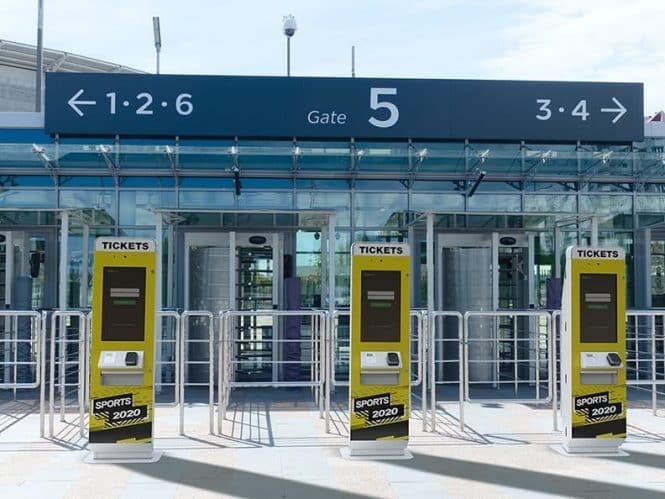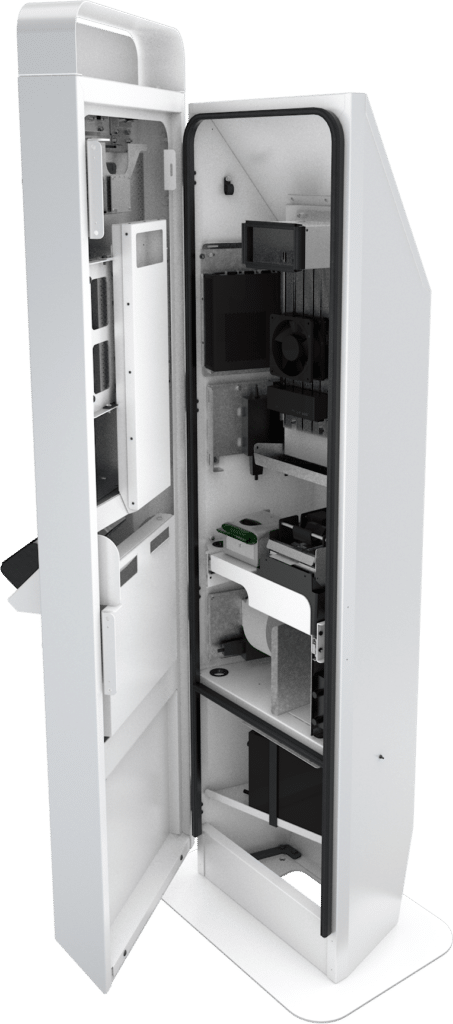
Table of Contents
Kiosk Design – How to Leverage Technology and Control Total Cost of Ownership
Edited from Olea Kiosk blog July 2021 Best Practices July 16, 2021
Introduction
As we continue to see technology adoption grow across the general population, there are opportunities for companies looking to expand their digital transformation using self-service kiosk solutions.
Not only are businesses looking for more effective digital front-doors, they’re also looking to automate certain processes to conduct more complex self-service interactions. Today’s self-service solutions need to play an integral part in the user experience which adds to customer retention, loyalty and satisfaction while contributing to profitability.
In order to create an experience that has a direct impact on the operator’s profitability, a good deal of thought has to go into the kiosk and its components.
Interactive Kiosk Functions
kiosk design example” src=”https://www.olea.com/wp-content/uploads/2021/07/Inside-Component.png” alt=”kiosk design example” width=”391″ height=”432″ /> kiosk design example
Self-service solutions have grown simply due to the many functions you can now deliver in a kiosk. Kiosks are highly customizable and can perform a number of functions including the following:
- Booking reservations
- Purchasing tickets
- Guest check-in
- Printing–tickets, cards, wrist bands
- Payment collection (via card or cash)
- Identity confirmation
- Signature collection
When the kiosk needs to perform several functions, it will also need a number of different components to be housed inside the enclosure. Today’s most common components include the following:
- POS device (point of sale)
- QR/barcode scanner
- Ticket printer
- Receipt printer
- Card encoder/decoder
- Web camera
- Microphone
- Coin/bill acceptor
- Biometric devices
The selection and combination of components is critical to delivering an intelligent and quality user experience.
Self-service kiosks are designed to put the guest in control. Kiosks are meant to reduce wait times and remove friction from the buying cycle. But if the components inside the kiosk can’t deliver the level of performance necessary, it can slow down the pace and degrade the level of service.
While there are many different component options available, all are not created equally. And neither are all self-service kiosk solutions.
When determining which components are selected, it’s important to look at the entire value chain to deliver the highest quality product for the best value. Evaluating the total cost of ownership is a significant piece of this process. And this is the value that Olea delivers. Our customers need to focus on their business and not get distracted by this part of the process.
In order to evaluate the total cost of ownership, the following need to be considered:
Kiosk Hardware Vetting
The selection of components and technology must be taken very seriously because of the need to deliver a solution that is sustainable and secure. It’s important to look at the where the product is at in its current lifecycle, future replacements, CAD data, and design support for integration into a kiosk. Overall availability of the product and avenues to purchase are also critical points.
Kiosk Enclosure Design
The components inside the kiosk need to be placed thoughtfully to ensure proper wiring and cable management and connection. The enclosure needs to protect the components and provide a secure environment with desirable aesthetics.
Application Integration
Not only do the devices need to be integrated to function together, they also need to work with the software that will signal the devices on what to do. Integrations allow for the flow of information to multiple applications to automate business processes and share information from one system to the next to deliver a feature-rich service environment.

Kiosk Serviceability
Evaluation should include consideration of the component MTBF (mean time between failure), what level of field service is necessary, and what level of service/repair should be done by the vendor. In addition, it’s important to evaluate consumables and determine the best ways to maintain and service the unit to extend its life.
The finished product is a finely tuned solution that processes the data and packages it up and sends it on to the next system.
Olea leverages its deep relationships with all of our partners across the ecosystem, hardware, software, POS, etc., to ensure we are dealing with the latest technology and understand the pros and cons around these devices. We’ve created a partner ecosystem centered around self-service delivery so we can attract and evolve with the most diverse and innovative partners to solve our client’s most difficult challenges.
The secret to ensuring a quality user experience is to balance high tech with high touch. We leverage the technology to reduce risk, improve consistency of performance, and increase responsiveness to user needs. And we look to trust-enabling technologies to create deeper customer relationships and loyalty. Olea Kiosks has tremendous experience in helping our customers understand how total cost of ownership impacts profitability. If you’d like to discuss how self-service kiosks can be used to boost productivity and improve the guest experience, contact us now to schedule a call.
More News From Olea Kiosks
-
Healthcare Kiosk – Olea Expands Healthcare, Telehealth and Telecare Market Solutions
-
Olea Kiosks®, Inc. Expands Leadership Team to Include Sales and Strategic Focus
